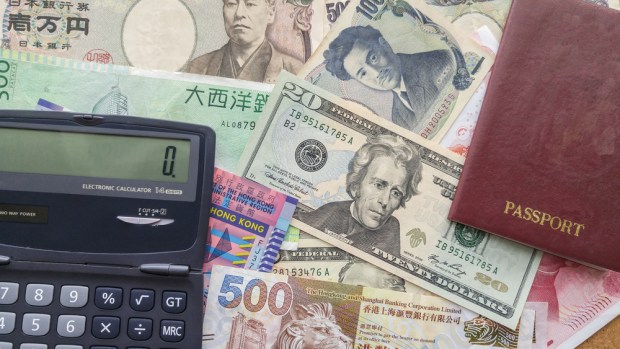X-Border Payments Optimization Tracker: Taking Loyalty And Rewards To The New Frontier

When traveling abroad, shopping often calls. But how can retailers turn foreign customers into loyalists? For the latest edition of the X-Border Payments Optimization Tracker™, PYMNTS caught up with Asad Jumabhoy, founder of cross-border loyalty platform UTU, to discuss how merchants can reach and build loyalty with international travelers. Find that, along with the latest cross-border headlines and a collection of more than 120 of the biggest players in the space, in this month’s Tracker.
It’s a truism that tourists and business travelers open their wallets — or the digital equivalent — when they go abroad. Indeed, spending on global business travel has been on the rise in the years since the Great Recession, reaching a record $1.2 trillion in 2015, according to the Global Business Travel Association.
The same goes for global tourism spending, which totaled $7.2 trillion in 2015, said the World Travel and Tourism Council.
And yet, foreign travelers can be an elusive target for the many restaurants, shops and other attractions seeking to lure them in. Airport billboards and tourist brochures would seem to be a rather crude way to reach tourists in the age of smartphones and digital marketing analytics.
Enter businessman and entrepreneur Asad Jumabhoy and his latest venture, UTU, an app-based platform that takes the loyalty and rewards concept across the border. UTU (pronounced you-too) is a coalition loyalty platform that allows travelers to receive offers from merchants in their destination country, earn points by shopping at those merchants and then redeem those points at any other merchant in the network, at home or abroad.
“What we want to allow merchants to do is talk to their potential customers coming in from foreign lands and give them a platform to reach them with rewards before they’ve even left for your country,” Jumabhoy told PYMNTS in a recent interview.
In turn, he noted, UTU allows travelers to be more strategic in planning their itineraries.
“All of us plan our travel very carefully — where we want to eat, what museums we want to go to, what shows we want to see — and more and more, time for leisure is getting compressed. People want to plan where they want to shop as well,” he said.
The heavy lifting
Of course, all of this is easier said than done. While developing the code for the platform only took about eight months, Jumabhoy said “connecting the dots” — between various issuers, acquirers, card networks and local taxing authorities — proved to be a challenging task.
“When dealing with cross-border, you’re dealing with tax jurisdictions as well,” he said. “It’s not just PCI compliance. You need to be compliant on a bilateral basis everywhere you go. So, it was really cracking the code to make yourself efficient on that front as well.”
This particular thicket, however, isn’t exactly unfamiliar territory for Jumabhoy. Way back in 1999 — a veritable eternity in the payments world — the Singapore-based businessman started Global Refund, which pioneered international tax-free shopping, as well as rapid currency conversion. Through this experience, Jumabhoy was able to recognize the many consumer and merchant frictions associated with the cross-border shopping experience.
Still, it took several years for Jumabhoy; his son, Ameer, a cofounder; and Jeremy Tan, a Singapore-based executive specializing in digital payment systems, to bring the concept to fruition.
Not that Jumabhoy is worse for wear.
“I think I’ve lost six kilos [14 pounds] in the last year,” Jumabhoy said. “I’m happy; my tailor is happy.”
The consumer and merchant experience
For all of the toiling behind the scenes, UTU is designed to be an effortless experience for consumers. It starts with downloading the app from the App Store or Google Play and creating an account with up to five reward-offering credits listed. Then, it’s time to start planning a trip — and fielding offers.
“When consumers shop overseas or at home, the issuer and the network want the same thing — for that consumer to shop with their card. Top of wallet is their goal. Issuers can offer consumers points for using their card on those trips or using it in a certain way or at certain merchant locations. Merchants can offer points for visiting them, and individual merchants can make offers,” Jumabhoy said.
Once a traveler arrives in the destination country, they simply swipe or dip their cards at participating retailers and get pings on their phones informing them of their rewards.
Consumers will have a choice whether “to bank those points or to cash out at the merchant with that purchase,” Jumabhoy explained.
Cashing out, in this case, means a statement credit from UTU for the amount of the reward. The system lets customers expend points if they leave their destination and return home with points to burn, where they can be used at local merchants or turned into card bonus points.
The platform is similarly designed to make life easy for merchants.
“We don’t touch the merchant till at all,” Jumabhoy said. “It’s really data transmission on the phone, the cloud, and that’s really how it goes. You don’t have the problem of training cashiers, saying, ‘I’m going to interrupt your sales process.’”
Marketing departments, however, will be able to use the platform to craft and fine-tune promotions.
“There’s a whole data [in the] science and analytics piece,” Jumabhoy said. “It’s about you knowing that, of the people at your store, 20 percent of them have lunch after. Maybe the two [businesses] should get together.”
“It’s also a question of moving from a fixed-cost basis of advertising to variable cost of sales, because, if you don’t sell anything, we don’t charge anything,” he added.
The launch, and beyond
UTU makes its debut this month in Thailand, and from there, the plan is to branch out to other Asian countries. As Jumabhoy has learned in his previous ventures, there’s already a “very healthy cross-border transactional channel” among a group of Asian countries.
This is borne out by a recent survey by Pitney Bowes, which found that cross-border shopping is especially popular in parts of Asia, including Singapore and Hong Kong.
Jumabhoy said he would next seek to expand to Europe — and then on to the U.S.
“We want to get out to the U.S. as soon as we can,” he said. “We’ve tested everything. It all works. We want to go live. There’ll be a few mistakes, but we’ll fix them as we go along, as everyone does.”
—-
To download the November edition of the PYMNTS X-Border Payments Optimization Tracker™, click the button below.
About The Tracker
The PYMNTS X-Border Payments Optimization Tracker™ is the framework for evaluating players in the cross-border payments landscape, and the quarterly index tests the readiness of the companies to serve a global audience.

